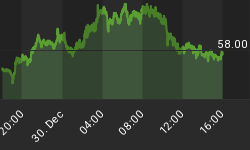Markets are forecasting mechanisms and they typically shift into a weak technical profile for a reason. One possible explanation for the concerning look of longer-term charts is a sharp drop in earnings expectations for U.S. companies. From Zack's Investment Research:
"We now have three quarters of back-to-back negative earnings growth and this picture isn't expected to change in the current (Q1) and following (Q2) periods either."
As shown on the graph below, it is possible the U.S. stock market will have to try to withstand five consecutive quarters of negative earnings growth.

Earnings And Recession Odds
Given the statistics below regarding two consecutive quarters of earnings declines and recessions, it begs the question how will the economy fare if earnings decline for five consecutive quarters? From CNBC:

Since corporate profits turned negative in mid-2015, Wall Street has pondered whether it's just a passing phase or a signal of something worse. History strongly suggests the latter. Recessions have followed consecutive quarters of earnings declines 81 percent of the time, according to an analysis from JPMorgan Chase strategists, who said they combed through 115 years of records for their findings. The news gets worse: Of the remaining 19 percent of the time, recession was only avoided through either monetary or fiscal stimulus. With the Federal Reserve holding limited easing options and a deeply dysfunctional Washington thwarting a fiscal boost, the prospects for help are not good.
Central Banks Have Limited Ammo
History says the economy has avoided a recession after two consecutive quarters of earnings declines in cases that included some form of monetary (Fed) or fiscal (Congress) stimulus. As described in detail in a recent video, the Fed's standard procedure for combating economic weakness is to lower interest rates. With rates still hovering around zero, the Fed has limited options in terms of leveraging their standard playbook. Major Wall Street firms are voicing concerns about the depleted arsenals of central banks. From Bloomberg:
"Central banks hold a declining number of less effective policy tools," writes Andrew Sheets, head of cross-asset strategy at Morgan Stanley. "Their latest foray, negative rates, may do more harm than good."
Largest Drop Since The Financial Crisis
The Wall Street Journal recently noted the last time the markets dealt with earnings revisions of this magnitude:

Wall Street's earnings estimates for S&P 500 companies are falling at the fastest pace since the height of the financial crisis. Since the start of 2016, Wall Street has gone from anticipating 0.3% growth in first-quarter earnings for S&P 500 companies to an 8% decline, according to FactSet. It's the biggest shift since the first two months of 2009.
Retail Sales Revised Downward
The latest read on the economy came Tuesday in the form of retail sales; it contained disappointing data. From Reuters:
U.S. retail sales fell less than expected in February, but a sharp downward revision to January's sales could reignite concerns about the economy's growth prospects... Retail sales excluding automobiles, gasoline, building materials and food services were unchanged after a downwardly revised 0.2 percent increase in January. These so-called core retail sales correspond most closely with the consumer spending component of gross domestic product and were previously reported to have risen 0.6 percent in January.
Investment Implications - The Weight Of The Evidence
With the Fed getting ready to take center stage, a lot of things can happen (good or bad) between now and the end of the week. However, given the facts we have in hand now, the longer-term outlook for stocks still falls into the concerning category as shown via the S&P 500 chart below.

The red line above is the 200-day moving average. The blue line is the S&P 500's 50-day moving average. They are used to keep an eye on the intermediate and longer-term trends in the stock market. The negative slopes of both moving averages tell us both the intermediate and long-term trends remain bearish despite the four week countertrend rally. This video clip puts the chart above in some historical context (2000-2002, 2007-2009). The chart above may improve, and we are open to that, but it has not shown meaningful improvement yet.
















